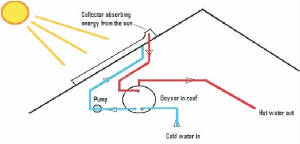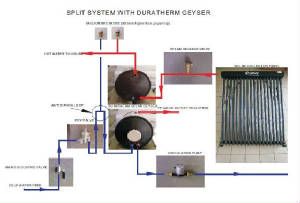|

- It is
called a split system because the solar collector and geyser are installed apart in that sense that the solar collector is
installed on top of the roof and the geyser installed inside the roof in a lower position as the solar collector.
- A split
system is the most commonly used system.
- Split
systems can be of the direct / open loop or indirect / closed loop type.
- When
using a direct / open loop system and water quality is under suspicion, do a water analysis at a lab to determine the water
quality. The water should have less than 600ppm of Total Dissolved Solids / Minerals. If the water quality is not up to standard,
use an indirect / closed loop system.
- In order
for any solar system to work there must be circulation between the solar collector and the geyser in order to take the heated
water from the solar collector to dump it into the geyser. With the Split system this is done
with an electrical (230V AC) or a 12 Volt DC
pump.
- To ensure
the system is always filled with water an air/steam release valve is installed at the outlet of the solar collector or at
the highest point of the installation. Air/steam collect at the highest point of a installation.
- A controller
is used to optimize the performance of the solar system and must be installed if an Eskom rebate is involved. When installing
a split system with a 12V pump a battery backup is essential in cold areas for the anti freezing facilities of the controller.
- The
controller makes the system freeze resistant and has a build in timer as required by Eskom.
- The
client qualifies for an Eskom rebate on the 150 liter and 200 liter split systems.
- The
Q factor is the name given to the power generated by a solar water heating system in testing by the SABS. Usually issued in
units of Mega Joules but can equally be expressed in Kilo Watt Hours.
- Nupower
submitted a 200 liter and 150 liter split system to SABS for testing and received the following Q factors;
150 liter
Q factor = 17.419 MJ or
4.84 kWh
200 liter Q factor = 23,885
MJ or 6.63
kWh
· Eskom
rebate on split systems are: 150 liter R2419.00
200 liter R3317.00

|

